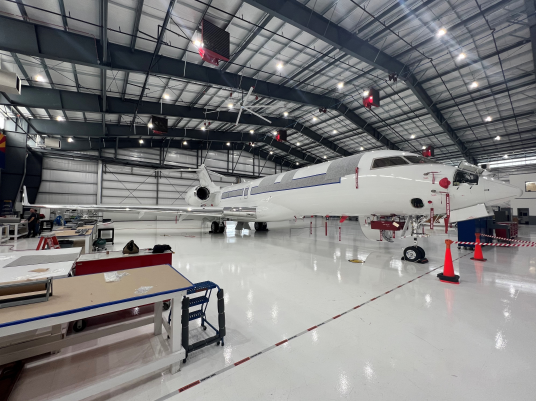SNC’s ISR Prototype Takes Shape As U.S. Army Readies Athena Awards

Sierra Nevada Corp.’s first Rapcon-X prototype takes shape at the company’s Hagerstown, Maryland, facility. This photo has been altered for security purposes.
HAGERSTOWN, Maryland—Sierra Nevada Corp.’s (SNC) new, small fleet of future contractor-owned, contractor-operated surveillance jets is taking shape in the company’s small hangar here, as the U.S. Army is set to award the first of a now two-step approach to the program.
The service last year kicked off the Army Theater-Level High-Altitude Expeditionary Next Airborne Intelligence, Surveillance and Reconnaissance (Athena) program for contractor aircraft to fly deployed ISR missions for the service. Athena is now broken up into two phases: Athena-R, which will have the aircraft fly with a government-furnished radar; and the follow-on Athena-S, which will have the upcoming High Accuracy Detection and Exploitation System (HADES) package of sensors. The award for the R phase is expected within weeks, with the S phase to follow.
Athena is the latest technology demonstrator program for the Army, following the Airborne Reconnaissance and Targeting Exploitation Multi-Mission Intelligence System (Artemis) and the Airborne Reconnaissance and Electronic Warfare System (ARES). These demonstrators are flying regular surveillance missions abroad, including watching the eastern edge of Europe during Russia’s invasion of Ukraine. The demonstrators are part of a campaign toward a future high-altitude sensing fleet that will be a mix of manned and unmanned aircraft.
The Army wants Athena to be four large cabin business jets that will help meet intelligence requirements until the HADES system is operational within the next few years. The Army wants to field all Athena systems by 2025.
“Artemis, ARES and Athena will not be fielded systems, but rather serve as interim A-ISR solutions to meet Army and Joint Force Commanders’ needs while the Army builds HADES,” the Army says in a statement. “They will also help the Army transition the crewed A-ISR enterprise from today’s capabilities to HADES, and provide valuable lessons learned to ensure success during HADES fielding and operations.”
SNC is spending about $200 million of its money to build a “turnkey” fleet of COCO ISR jets for the program, buying Bombardier Global 6500s that are being modified at its Hagerstown facility, says Tim Harper, the senior director of business development for SNC’s Mission Solutions and Technologies. Aviation Week got an exclusive look at the first of the two jets that is being outfitted with SNC equipment and other changes, including the “canoe” on the jet’s belly that will fit the radar. While the first is being modified, the second was receiving paint at another site.
The company is planning for flight testing in the fall and potential delivery in early 2024.
SNC named its aircraft Rapcon-X, meaning “rapidly configurable to the X degree.” It is a nod to how the company is designing the jet to be quickly outfitted with different equipment depending on the mission.
For Athena-R, SNC is incorporating the Army-provided Northrop Grumman Long-Range Radar that was previously used in its now-retired fleet of Airborne Reconnaissance Low-Enhanced DHC-80-315 aircraft. SNC has also procured Leonardo Osprey 50 Active Electronically Scanned Array radars.
SNC is installing a thin satellite communications system on top of the aircraft, capable of 400 to 1,000 mbps from satellites in low, medium and geosynchronous Earth orbit. The system is set for Ka band frequencies and can be adjust for Ku band, Harper says.
The aircraft will be outfitted with electronic countermeasures, including BriteCloud active radar decoys.
Inside, the cockpit is being modified for additional displays for sensors and radars. There are three workstations for operators and nine mission racks for equipment.
The Artemis aircraft, a Leidos-owned Bombardier Challenger 650, is flying with SNC’s SS-4000 electronic intelligence payload. Rapcon-X will have SNC’s newer AE-4500 system. Interior work has been ongoing for about a year now, ahead of the first aircraft deliveries, Harper says.
The Bombardier Global 6500 is the favorite for the Athena program, and the Army in an August 2022 request for information called for integration on the aircraft for HADES for planning assumptions. Harper says the aircraft’s Rolls-Royce Pearl 15 engine has excess power and the range needed for the mission. The jet is rated for 6,000-mi. range conservatively, with 14 hr. of endurance, and Harper says Rapcon-X will be able to fly to an altitude in the high 40,000-ft. range.
SNC started its work on the Rapcon-X ahead of the Army announcing its Athena plans to anticipate future contractor ISR efforts, and to get a head start on what would come next, Harper says.
